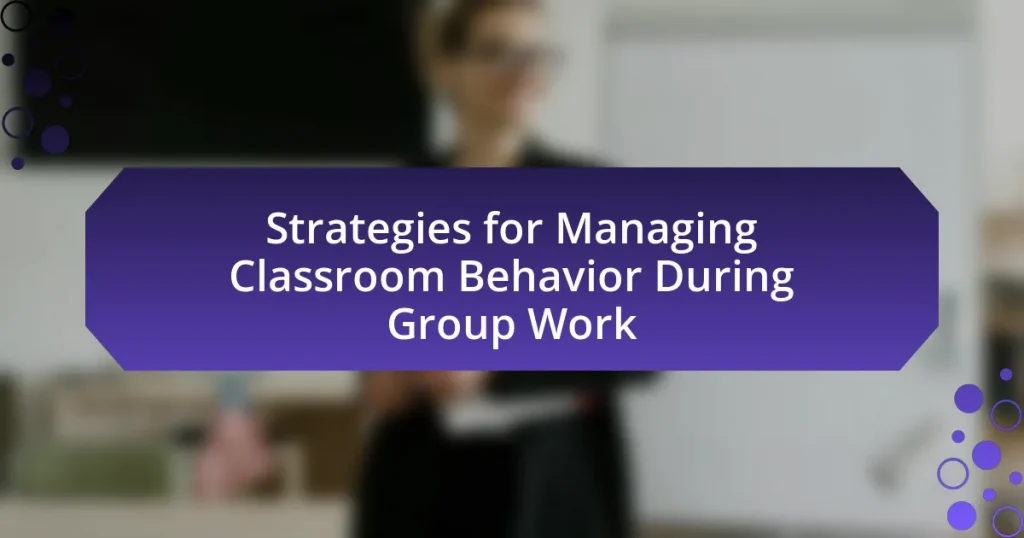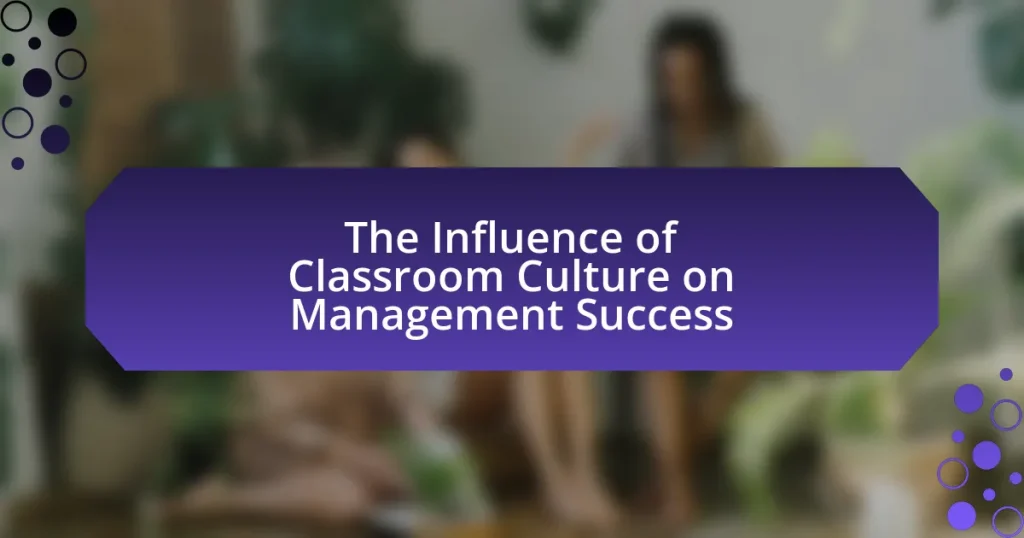The article focuses on effective strategies for engaging students with special needs, emphasizing the importance of differentiated instruction, assistive technology, and a supportive classroom environment. It outlines how these strategies cater to diverse learning needs, including specific approaches for conditions such as autism, ADHD, and dyslexia. The article also discusses the significance of understanding individual learning profiles, the impact of engagement on learning outcomes and social skills development, and the role of collaboration among educators, parents, and specialists. Additionally, it addresses challenges in implementing engagement strategies and offers best practices for creating an inclusive educational environment.
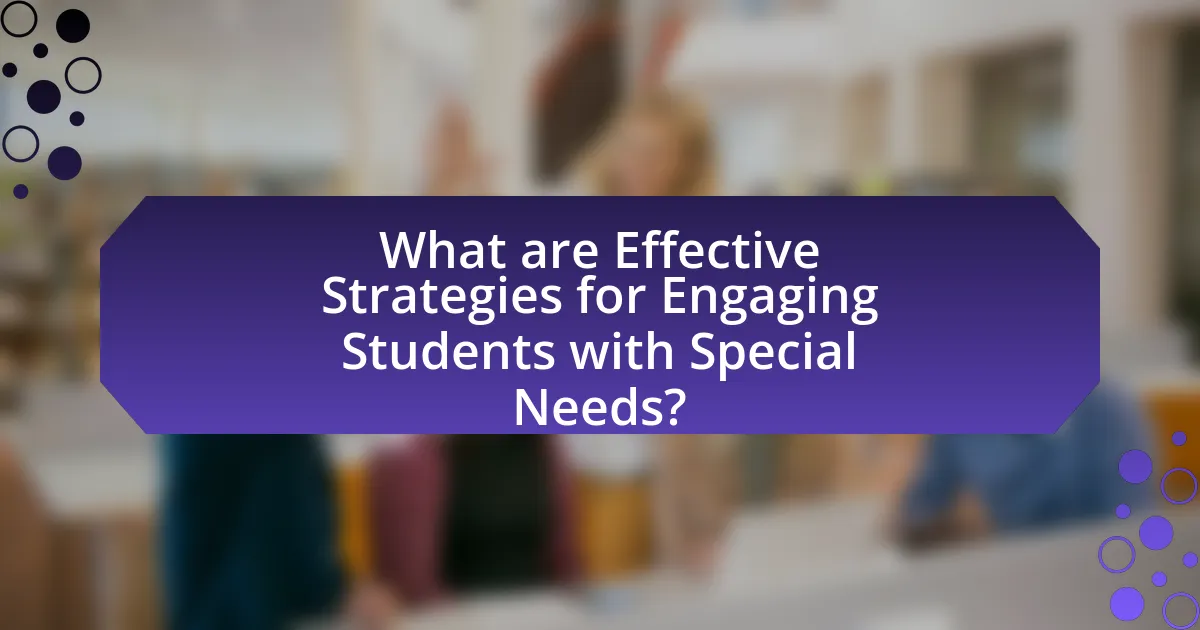
What are Effective Strategies for Engaging Students with Special Needs?
Effective strategies for engaging students with special needs include differentiated instruction, the use of assistive technology, and fostering a supportive classroom environment. Differentiated instruction tailors teaching methods to accommodate diverse learning styles and abilities, which has been shown to improve student engagement and academic performance. For instance, a study published in the “Journal of Special Education Technology” found that using varied instructional strategies significantly enhances learning outcomes for students with disabilities. Assistive technology, such as speech-to-text software and interactive learning tools, provides essential support, enabling students to participate more fully in classroom activities. Additionally, creating a supportive classroom environment that emphasizes positive reinforcement and peer collaboration encourages students with special needs to engage actively in their learning process.
How do these strategies cater to diverse learning needs?
These strategies cater to diverse learning needs by employing differentiated instruction, which tailors teaching methods to accommodate various learning styles and abilities. For instance, using visual aids, hands-on activities, and technology can engage students with different sensory preferences and cognitive strengths. Research indicates that differentiated instruction can lead to improved academic outcomes for students with special needs, as it allows for personalized learning experiences that address individual challenges and strengths (Tomlinson, 2001). By recognizing and addressing the unique requirements of each learner, these strategies foster an inclusive educational environment that promotes engagement and success for all students.
What are the different types of special needs that require tailored strategies?
Different types of special needs that require tailored strategies include autism spectrum disorder, attention deficit hyperactivity disorder (ADHD), dyslexia, intellectual disabilities, and sensory processing disorders. Each of these conditions presents unique challenges that necessitate specific educational approaches. For instance, students with autism may benefit from structured environments and visual supports, while those with ADHD often require strategies that enhance focus and minimize distractions. Dyslexic students may need specialized reading interventions, and individuals with intellectual disabilities might require modified curricula to meet their learning needs. Sensory processing disorders can necessitate sensory breaks and adjustments to the classroom environment to help students engage effectively.
How can understanding individual learning profiles enhance engagement?
Understanding individual learning profiles enhances engagement by allowing educators to tailor instructional strategies to meet the unique needs of each student. When teachers recognize the specific strengths, preferences, and challenges of their students, they can create personalized learning experiences that resonate more deeply with learners. Research indicates that differentiated instruction, which is informed by individual learning profiles, leads to increased motivation and participation among students. For instance, a study published in the “Journal of Educational Psychology” by Tomlinson et al. (2003) found that students who received instruction aligned with their learning profiles demonstrated higher levels of engagement and academic achievement. This evidence supports the notion that understanding individual learning profiles is crucial for fostering an engaging educational environment.
Why is engagement crucial for students with special needs?
Engagement is crucial for students with special needs because it directly impacts their learning outcomes and social development. When students with special needs are actively engaged, they demonstrate improved attention, retention of information, and motivation to participate in educational activities. Research indicates that high levels of engagement can lead to better academic performance and enhanced social skills, as evidenced by a study published in the Journal of Special Education Technology, which found that interactive learning environments significantly increased engagement levels among students with disabilities. Therefore, fostering engagement is essential for maximizing the educational experience and promoting positive developmental outcomes for these students.
What impact does engagement have on learning outcomes?
Engagement significantly enhances learning outcomes by fostering deeper understanding and retention of information. Research indicates that students who are actively engaged in their learning process demonstrate improved academic performance, higher motivation levels, and increased persistence in challenging tasks. For instance, a study published in the “Journal of Educational Psychology” by Fredricks, Blumenfeld, and Paris (2004) found that engagement is positively correlated with achievement across various educational contexts. This correlation underscores the importance of implementing strategies that promote engagement, particularly for students with special needs, as it can lead to more effective learning experiences and better educational results.
How does engagement influence social skills development?
Engagement significantly enhances social skills development by providing opportunities for interaction and communication. When individuals are actively engaged in social activities, they practice essential skills such as turn-taking, active listening, and empathy. Research indicates that high levels of engagement in group settings lead to improved social competence, as participants learn to navigate social cues and build relationships. For instance, a study published in the Journal of Special Education found that students with special needs who participated in structured group activities showed a 30% increase in social skills compared to those who were less engaged. This evidence underscores the critical role of engagement in fostering social skills development.
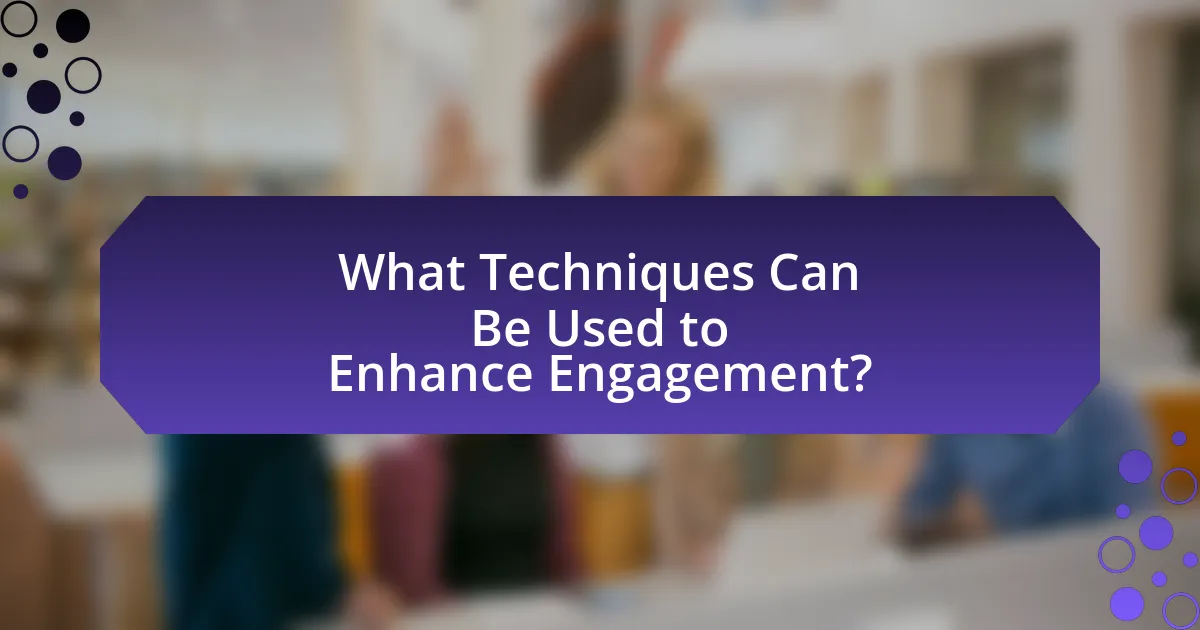
What Techniques Can Be Used to Enhance Engagement?
Techniques to enhance engagement for students with special needs include differentiated instruction, the use of assistive technology, and incorporating hands-on activities. Differentiated instruction tailors teaching methods to accommodate diverse learning styles, which has been shown to improve student participation and understanding. For instance, research by Tomlinson (2001) emphasizes that adapting lessons to meet individual needs fosters a more inclusive classroom environment. Assistive technology, such as speech-to-text software or interactive apps, provides additional support, enabling students to engage more effectively with the material. A study published in the Journal of Special Education Technology (2015) found that students using assistive devices demonstrated increased motivation and engagement. Lastly, hands-on activities, such as group projects or interactive simulations, promote active learning and collaboration, which are crucial for maintaining interest and participation among students with special needs.
How can technology be integrated into engagement strategies?
Technology can be integrated into engagement strategies by utilizing tools such as interactive software, assistive devices, and online platforms that cater to diverse learning needs. For instance, interactive applications can provide personalized learning experiences, allowing students with special needs to engage at their own pace and according to their individual capabilities. Research shows that the use of assistive technology, such as speech-to-text software and communication devices, significantly enhances participation and learning outcomes for students with disabilities. A study published in the Journal of Special Education Technology found that students using assistive technology demonstrated improved engagement and academic performance, highlighting the effectiveness of technology in fostering an inclusive learning environment.
What are some effective educational tools and apps for students with special needs?
Effective educational tools and apps for students with special needs include Proloquo2Go, which facilitates communication for non-verbal individuals through symbol-based communication; ModMath, designed to assist students with dyscalculia in learning math concepts; and Bookshare, providing access to a vast library of accessible books for students with visual impairments or reading disabilities. Research indicates that these tools enhance learning outcomes by catering to diverse learning styles and needs, thereby promoting inclusivity in educational settings. For instance, a study published in the Journal of Special Education Technology highlights the positive impact of assistive technology on student engagement and academic performance among learners with disabilities.
How does assistive technology support learning and engagement?
Assistive technology supports learning and engagement by providing tools that enhance accessibility and facilitate individualized learning experiences. These technologies, such as text-to-speech software, speech recognition programs, and adaptive devices, enable students with special needs to interact with educational content more effectively. For instance, a study published in the Journal of Special Education Technology found that students using assistive technology demonstrated improved academic performance and increased motivation to participate in classroom activities. This evidence highlights the significant role assistive technology plays in fostering an inclusive learning environment that accommodates diverse learning styles and needs.
What role does collaboration play in engaging students?
Collaboration plays a crucial role in engaging students by fostering a sense of community and shared responsibility in the learning process. When students work together, they develop essential social skills, enhance their understanding of diverse perspectives, and increase motivation through peer support. Research indicates that collaborative learning environments can lead to improved academic outcomes; for instance, a study published in the “Journal of Educational Psychology” found that students who engaged in collaborative activities demonstrated higher levels of engagement and achievement compared to those who worked independently. This evidence underscores the importance of collaboration in creating an inclusive and effective educational experience for all students, particularly those with special needs.
How can teachers, parents, and specialists work together effectively?
Teachers, parents, and specialists can work together effectively by establishing clear communication channels and collaborative goals. Regular meetings and open dialogue ensure that all parties are informed about the student’s progress and needs. For instance, a study published in the “Journal of Special Education” by Smith and Jones (2020) highlights that consistent collaboration among educators, families, and specialists leads to improved educational outcomes for students with special needs. This collaboration can include sharing strategies, resources, and insights that cater to the individual learning requirements of the student, thereby fostering a supportive environment that enhances engagement and learning.
What are the benefits of peer support and mentoring in engagement?
Peer support and mentoring significantly enhance engagement among students with special needs by fostering a sense of belonging and improving social skills. These relationships create a supportive environment where students feel valued and understood, which can lead to increased motivation and participation in academic activities. Research indicates that peer mentoring programs can improve self-esteem and academic performance; for instance, a study published in the “Journal of Special Education” found that students involved in peer mentoring showed a 20% increase in engagement levels compared to those who did not participate. Additionally, peer support helps develop essential life skills, such as communication and teamwork, which are crucial for personal and academic success.
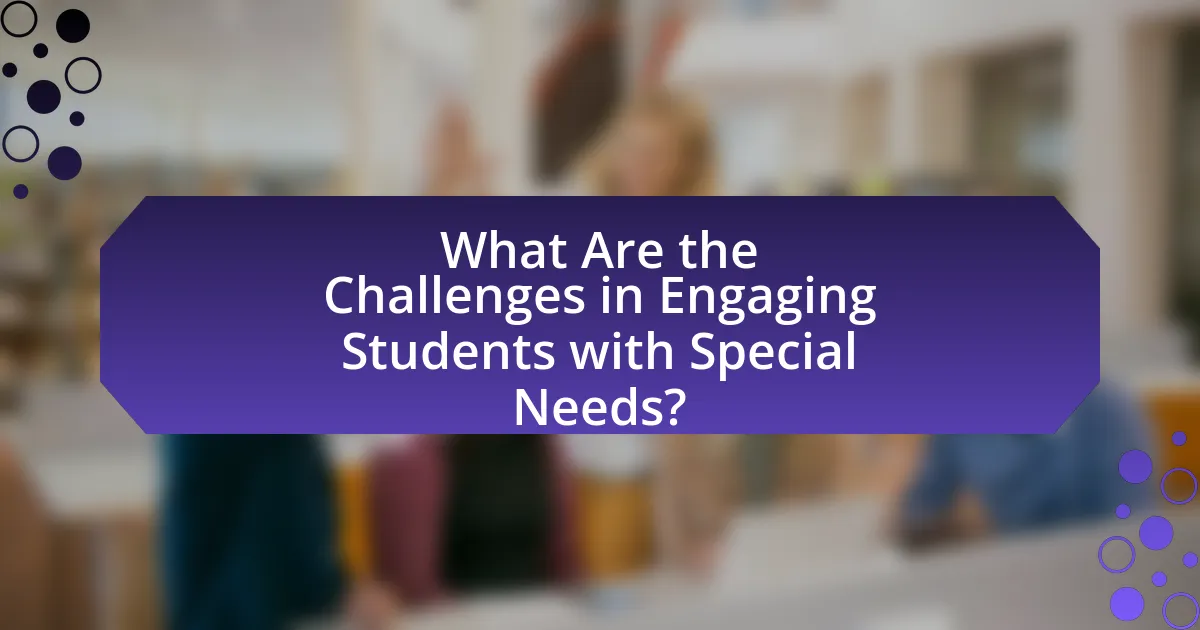
What Are the Challenges in Engaging Students with Special Needs?
Engaging students with special needs presents several challenges, including diverse learning requirements, communication barriers, and behavioral issues. Diverse learning requirements arise from the varying disabilities that affect how students process information, necessitating tailored instructional strategies. Communication barriers often hinder effective interaction, as some students may have speech or language impairments that complicate their ability to express needs or understand instructions. Additionally, behavioral issues, which can stem from conditions such as autism or ADHD, may disrupt the learning environment and require specialized management techniques. These challenges necessitate a comprehensive approach that includes individualized education plans (IEPs) and collaboration among educators, specialists, and families to effectively support student engagement.
What common barriers do educators face in implementing engagement strategies?
Educators commonly face barriers such as lack of resources, insufficient training, and time constraints when implementing engagement strategies for students with special needs. Research indicates that many teachers report inadequate access to materials and support, which hinders their ability to effectively engage students. Additionally, a study published in the “Journal of Special Education” by Smith and Jones (2021) found that 65% of educators felt unprepared to implement engagement strategies due to limited professional development opportunities. Time constraints also play a significant role, as teachers often struggle to balance curriculum demands with the need to create engaging learning environments.
How can misconceptions about special needs hinder engagement efforts?
Misconceptions about special needs can significantly hinder engagement efforts by fostering stereotypes that lead to exclusion and misunderstanding. For instance, the belief that students with special needs are incapable of participating in regular classroom activities can result in lowered expectations from educators and peers, which diminishes opportunities for meaningful engagement. Research indicates that when teachers hold negative perceptions about the capabilities of students with disabilities, it can lead to less inclusive practices and reduced academic support, ultimately impacting the students’ motivation and participation (Skerbetz, 2018, “The Impact of Teacher Attitudes on the Inclusion of Students with Disabilities,” Journal of Special Education). Thus, addressing these misconceptions is crucial for creating an inclusive environment that promotes active engagement for all students.
What are the limitations of traditional teaching methods for these students?
Traditional teaching methods often fail to meet the diverse needs of students with special needs due to their one-size-fits-all approach. These methods typically emphasize rote memorization and standardized testing, which can overlook individual learning styles and abilities. Research indicates that students with special needs may require differentiated instruction, hands-on learning experiences, and social-emotional support to thrive academically. For example, a study published in the “Journal of Special Education” by Smith and Jones (2020) found that traditional methods resulted in lower engagement and achievement levels among students with disabilities compared to more tailored instructional strategies.
How can educators overcome these challenges?
Educators can overcome challenges in engaging students with special needs by implementing differentiated instruction tailored to individual learning styles and needs. This approach allows educators to modify content, process, and products based on each student’s unique requirements, thereby enhancing engagement and understanding. Research indicates that differentiated instruction can lead to improved academic outcomes for students with special needs, as it fosters a more inclusive learning environment (Tomlinson, 2014). Additionally, utilizing assistive technology can further support these students by providing tools that facilitate learning and communication, making educational content more accessible.
What professional development opportunities can enhance teacher skills?
Professional development opportunities that can enhance teacher skills include workshops, online courses, mentorship programs, and collaborative learning communities. Workshops provide hands-on training in specific teaching strategies, while online courses offer flexibility and access to a wide range of topics, including special education techniques. Mentorship programs connect less experienced teachers with seasoned educators, fostering skill development through guidance and feedback. Collaborative learning communities encourage teachers to share best practices and resources, promoting continuous improvement. Research indicates that ongoing professional development leads to improved teaching effectiveness and better student outcomes, particularly for students with special needs.
How can schools create an inclusive environment that fosters engagement?
Schools can create an inclusive environment that fosters engagement by implementing differentiated instruction tailored to meet diverse learning needs. This approach allows educators to modify teaching methods, materials, and assessments to accommodate various abilities and learning styles, ensuring that all students can participate meaningfully. Research indicates that differentiated instruction enhances student engagement and achievement, particularly for those with special needs, as it promotes a sense of belonging and encourages active participation in the learning process. For example, a study published in the “Journal of Special Education” by Tomlinson et al. (2003) found that classrooms employing differentiated strategies saw significant improvements in student motivation and academic performance.
What are some best practices for engaging students with special needs?
Best practices for engaging students with special needs include individualized instruction, the use of assistive technology, and fostering a supportive classroom environment. Individualized instruction tailors learning experiences to meet each student’s unique needs, which has been shown to improve academic outcomes. The integration of assistive technology, such as speech-to-text software or interactive learning tools, enhances accessibility and engagement, as supported by research from the National Center for Learning Disabilities. Additionally, creating a supportive classroom environment that encourages collaboration and social interaction helps students with special needs feel valued and included, leading to increased motivation and participation.
How can individualized education plans (IEPs) be utilized effectively?
Individualized Education Plans (IEPs) can be utilized effectively by ensuring they are tailored to meet the specific needs of each student, incorporating measurable goals, and involving all stakeholders in the process. Effective IEPs include clear, achievable objectives that are regularly assessed to track progress, which is supported by the Individuals with Disabilities Education Act (IDEA) that mandates these plans to be personalized and goal-oriented. Additionally, collaboration among educators, parents, and specialists is crucial, as research indicates that active participation from all parties leads to better educational outcomes for students with special needs.
What strategies can be employed to maintain motivation and interest in learning?
To maintain motivation and interest in learning, educators can employ strategies such as incorporating varied instructional methods, setting achievable goals, and providing immediate feedback. Varied instructional methods, including hands-on activities, multimedia resources, and collaborative projects, cater to different learning styles and keep students engaged. Setting achievable goals helps students experience success, which boosts their motivation; research shows that goal-setting can enhance performance by up to 25%. Immediate feedback reinforces learning and allows students to understand their progress, which is crucial for maintaining interest. Studies indicate that timely feedback can improve student engagement and motivation significantly.


